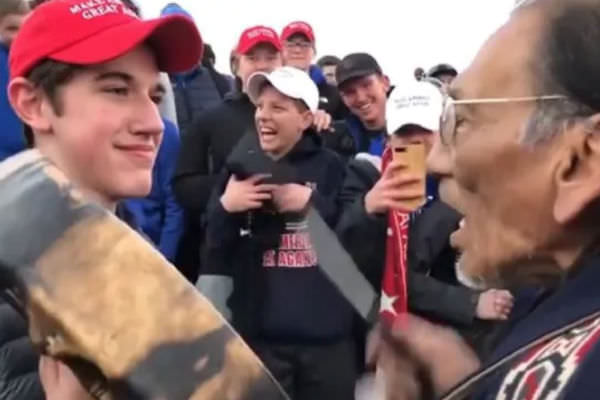A group of high school students from Covington Catholic High School wait at the Lincoln Memorial in Washington, DC, to catch a bus back to Kentucky. On arriving home, they discover a short video clip on social media has catapulted them into the eye of a storm.
 It appears to show them surrounding and mocking a Native American elder. They are mainly white private school boys from rural America, and they are Catholics who have attended the annual March for Life; some are wearing red Make America Great Again caps.
It appears to show them surrounding and mocking a Native American elder. They are mainly white private school boys from rural America, and they are Catholics who have attended the annual March for Life; some are wearing red Make America Great Again caps.
An avalanche of condemnation descends — media, celebrities, politicians, their own school, and even bishops and archbishops. Some seek to disassociate themselves, genuinely shocked by what they believe they saw; others are intent on really putting the boot in, not only for what was alleged but for what the boys represent. The MAGA caps were red rags to liberal bulls; liberal Catholics, uneasy with the conservative bent of the March for Life (which attracted 250,000 participants but little publicity until this story broke) seized on the incident as confirming their worst fears; and there was more than a little dog-whistling by sectarian bigots intent on discrediting the Catholic Church.
How to make sense of this story? Is there any relevance to Australia? The rush to judgment without testing the evidence or hearing both sides was regrettable, particularly as the target of this torrent of condemnation was a group of teenagers. It was not just the story but the online comments that flowed from every post. Condemnations in the thousands, hate speech, doxing (posting private information such as the boys' names and addresses) and death threats. The bloodlust in many online comments showed the ugly face of social media and the dangers of instant reporting and reactions. Caitlin Flanagan, in an article in The Atlantic headlined 'The media botched the Covington Catholic story', documents the failings of the media.
As one who has spent his entire working life in education, my first reaction was concern about the impact of this commentary on the teenagers. It touched on a broader educational and social issue — all of us who are familiar with something of the world of our young are worried about the online bullying that follows the young person relentlessly into the privacy of their homes. Children can feel there is no escape, and we regularly experience the tragedies of children taking their lives in fear and despair. Yet because this story is in the political arena, it seems vicious comments from celebrities, politicians, and countless others are made with impunity. And we wonder why young people can be so cruel online and why it is so hard to educate them that words matter; that words hurt.
Then, as they say, the story got complicated. It turned out there were two hours of video that appeared to give a very different take on the story. Some apologised, media outlets walked back parts of the story, tweets and posts were deleted, and supporters of Donald Trump were galvanised as the narrative played into their claims of fake news. More was revealed. Waiting for the bus, the boys were harassed by a small group of Black Hebrew Israelites, a group known for its vitriolic denunciations of everything from religion to LGBTI to Trump. The video shows them initially mocking the Native American protesters. They then turn on the boys, who are watching the exchanges.
On the whole the boys, to their credit, do not respond in kind to a train of insults. There is one moment when the Black Hebrew Israelites shout to a black Covington boy that his friends are going to kill him and steal his organs. A young white man turns to his classmate, touches him, and says: 'But we love you.' As one commentator noted, there's also the moment when the black nationalists declare that 'your President is a homosexual' and a high school kid responds, 'Who cares?' Hardly the stuff of budding Klansmen.
"All of us who work with young people know the danger of the mob mentality. We are acutely aware of how easily racist, homophobic or sexist comments are made. Single-sex schools can have particular responsibilities here to ensure a respectful culture."
The boys resort to singing their school chants to drown out the abuse. There is emotion, noise and energy. Then Native American elder and activist Nathan Phillips walks into the middle of the group of boys (the boys do not, as originally reported, move in to surround him). His stated intention was to intervene. It may be, too, that amid the noise and taunts from the Black Israelites, and with many boys wearing MAGA caps, that he assumed certain things. He comes face to face with 16-year-old Nick Sandmann, who holds his ground, smiling, as Phillips beats the drum held up to his face.
All of us who work with young people know the danger of the mob mentality. We are acutely aware of how easily racist, homophobic or sexist comments are made. Single-sex schools can have particular responsibilities here to ensure a respectful culture. And in a Catholic context, this goes to the heart of faith and a conviction that every person is made in the image and likeness of God, and is to be respected fully as such. Such conviction lies at the centre of the March for Life.
In my experience, we have made considerable progress in school cultures in terms of respect around race and sexual orientation, though the field of gender is more complicated and sexist attitudes are harder to address. Indeed, there is some video evidence that some of the Covington boys may have something to answer for in this regard.
Were the boys saints? Almost certainly not. At times they may well have been boorish, as teens in groups can be. Certainly, where an elder was a guest, where they knew the reason for his presence and the significance of the drum and what was being played, one would expect different standards. But in the noise and excitement, and under verbal assault and surprised by his presence, they were boisterous, yet not intentionally demeaning or insulting. After the verbal onslaught from the Black Hebrew Israelites and the arrival of Phillips in their midst, one of the boys is heard to say: 'I am so confused.'
There appears to be no evidence of them chanting 'build the wall', nor of any racist remarks. In their cheering and dancing, the tomahawk chop is made by a few students — it is often used in crowds at sporting events. While it is widely seen as offensive by Native Americans, its use in the face of the unannounced appearance of Phillips need not be seen as racist in intent. To me, much of the imagery reminds me of groups of student supporters at sporting events. Other boys are seen dancing with the music, as one of the Native Americans there later acknowledged.
Indeed, if the intention of Phillips was to defuse the situation, then he was largely successful in that the focus shifted to the music and away from the Black Hebrew Israelites. And if Sandmann's intention was to stand his ground and smile at the elder with the drum in his face, so as to defuse tension, then he was successful. There does not have to be a bad guy in this confused and noisy encounter.
We may never know the intentions of those involved. What is clear is that we are still coming to understand the impact of social media on the news cycle and on life in general. Surely where it includes targeting the young we need to tread more carefully. What I find amazing is how few have addressed the torrent of invective in the online comments under the banners of reputable news agencies — threats of violence, sectarianism, exposing student names and addresses, comparisons to Nazism and so on — with no sense of irony, given what the boys were accused of.
And finally, to the politics that churn around this story. Was the real crime of the Covington students to wear MAGA caps and to come from Kentucky? In the eyes of many, this justified any level of abuse. Joy Behar on her TV talk show The View readily admits it when Whoopi Goldberg asks why the rush to judgment. Lashing out at the students was lashing out at Trump. For some there were strong echoes of the hysteria swirling around the Brett Kavanaugh hearings over his Supreme Court nomination.
The reaction to this incident speaks to a dangerous polarisation in American society. But if wearing a cap that reflects a political viewpoint or participating in a peaceful march for a cause you believe in can be justifications for any response, from slander to threats against teenagers, then we are in a bad place. It is a challenge we face here in Australia, and if any good can come from this story it might be that it encourages us to pull back from the precipice of all-out war in our national dialogue. We saw its dangers in the same-sex marriage debate. We saw it on St Kilda beach this summer, itself reminiscent of the Cronulla riots. The extremes on the Right and Left are active.
There are genuine debates to be had around freedom of expression and religious freedom. Many of us would agree on the need for improved public discourse that is civil and reasoned and respectful of difference. The Covington story vividly illustrates the challenges facing us.
 Fr Chris Middleton SJ is the rector of Xavier College in Melbourne. This piece was first published in The Weekend Australian (26-27 January 2019).
Fr Chris Middleton SJ is the rector of Xavier College in Melbourne. This piece was first published in The Weekend Australian (26-27 January 2019).